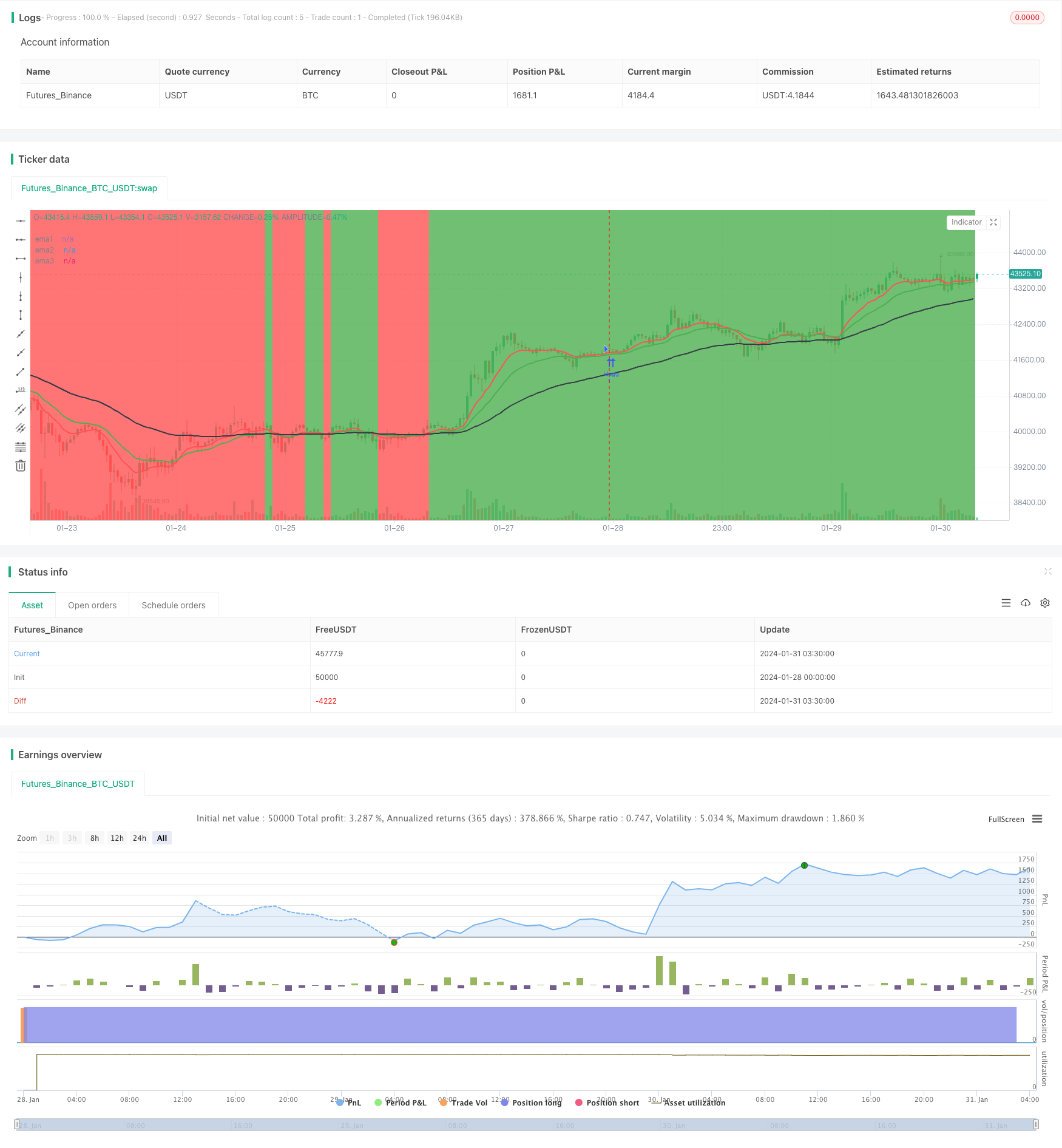
概述
该策略基于3条不同周期的EMA平均线,通过判断价格是否处于EMA平均线之上,来判断目前的趋势方向。当短期EMA线上穿长期EMA线时生成买入信号;当短期EMA线下穿长期EMA线时生成卖出信号。该策略追踪趋势运行,在趋势转向时及时平仓。
策略原理
该策略使用3条EMA平均线,分别是10日线、20日线和50日线。其判断规则为:
当10日EMA线和20日EMA线同时位于50日EMA线之上时,定义为上升趋势;
当10日EMA线和20日EMA线同时位于50日EMA线之下时,定义为下降趋势;
当短期EMA线(10日线和20日线)上穿长期EMA线(50日线)时产生买入信号;
当短期EMA线(10日线和20日线)下穿长期EMA线(50日线)时产生卖出信号;
在上升趋势中持有多头仓位,下降趋势中持有空头仓位;
在趋势转向时(EMA短期线与长期线发生穿透)平掉当前信号方向的头寸。
该策略通过 capture profit,通过及时平仓锁定盈利的方式轮番进行多空操作。
优势分析
该策略具有以下优势:
- 规则简单清晰,容易理解和实现;
- 利用EMA平均线判断趋势方向,避免被市场短期波动干扰;
- 及时平仓,追踪趋势运行,避免亏损扩大;
- 无需预测行情方向,跟踪趋势运行,胜率较高。
风险分析
该策略也存在一些风险:
- 在盘整市的时候,EMA平均线之间容易出现多次穿透,可能频繁开仓平仓带来交易成本;
- 行情跳空后EMA判断趋势的效果会受到影响,可能错失良好的开仓机会。
针对以上风险,可以通过以下方法加以优化:
- 在EMA间距较小时,可以适当放宽开仓规则,避免过于频繁交易;
- 结合其他指标确定趋势,避免EMA判断失效的情况。
优化方向
该策略可以从以下几个方向进行优化:
参数优化。可以测试不同EMA周期的参数组合,找到最佳的参数;
交易成本优化。适当优化开仓规则,减少不必要的频繁交易;
止损策略优化。设定合理的止损水平,控制单笔损失;
结合其他指标。运用MACD,KDJ等其他指标辅助判断,优化入场时机。
总结
该策略整体来说较为简单实用。其利用EMA判断趋势运行方向,附带适当的止损策略,可以有效控制风险。同时也存在一些优化空间,若果结合参数优化、止损策略、其他指标等,该策略的效果还具有很大提升空间。
策略源码
/*backtest
start: 2024-01-28 00:00:00
end: 2024-01-31 04:00:00
period: 45m
basePeriod: 5m
exchanges: [{"eid":"Futures_Binance","currency":"BTC_USDT"}]
*/
// This source code is subject to the terms of the Mozilla Public License 2.0 at https://mozilla.org/MPL/2.0/
// © mattehalen
//@version=4
//study("EMA 10,20 59",overlay=true)
strategy("EMA 10,20 59",overlay=true)
infoBox = input(true, title="infoBox", type=input.bool)
infoBox2 = input(false, title="infoBox2", type=input.bool)
BuySellSignal_Bool = input(false, title="Buy & SellSignal", type=input.bool)
infoBoxSize = input(title="infoBoxSize", defval=size.large, options=[size.auto, size.tiny, size.small, size.normal, size.large, size.huge])
ema1Value = input(10)
ema2Value = input(20)
ema3Value = input(59)
maxLoss = input(3000)
ema1 = ema(close,ema1Value)
ema2 = ema(close,ema2Value)
ema3 = ema(close,ema3Value)
objcnt = 0
buyTitle = tostring(close[1])
myProfit = float(0)
plot(ema1,title="ema1",color=color.red,linewidth=2)
plot(ema2,title="ema2",color=color.green,linewidth=2)
plot(ema3,title="ema3",color=color.black,linewidth=2)
Buytrend = (ema1 and ema2 > ema3) and (ema1[1] and ema2[1] > ema3[1])
BarssinceBuyTrend = barssince(Buytrend)
BarssinceSellTrend = barssince(not Buytrend)
closeAtBuyTrend = close[1]
bgcolor(Buytrend ? color.green : color.red,transp=70)
BuySignal = Buytrend and not Buytrend[1] and BuySellSignal_Bool
BuySignalOut = Buytrend and (crossunder(ema1,ema2)) and BuySellSignal_Bool
BarssinceBuy = barssince(BuySignal)
bgcolor(BuySignal ? color.green : na , transp=30)
bgcolor(BuySignalOut ? color.black : na , transp=30)
plot(BarssinceBuy,title="BarssinceBuy",display=display.none)
SellSignal = not Buytrend and Buytrend[1] and BuySellSignal_Bool
SellSignalOut = not Buytrend and (crossover(ema1,ema2)) and BuySellSignal_Bool
BarssinceSell = barssince(SellSignal)
bgcolor(SellSignal ? color.red : na , transp=30)
bgcolor(SellSignalOut ? color.black : na , transp=30)
plot(BarssinceSell,title="BarssinceSell",display=display.none)
buyProfit = float(0)
cntBuy =0
sellProfit = float(0)
cntSell =0
buyProfit := Buytrend and not Buytrend[1]? nz(buyProfit[1]) + (close[BarssinceBuyTrend[1]]-close) : nz(buyProfit[1])
cntBuy := Buytrend and not Buytrend[1]? nz(cntBuy[1]) + 1: nz(cntBuy[1])
sellProfit := not Buytrend and Buytrend[1]? nz(sellProfit[1]) + (close-close[BarssinceSellTrend[1]]) : nz(sellProfit[1])
cntSell := not Buytrend and Buytrend[1]? nz(cntSell[1]) + 1 : nz(cntSell[1])
totalProfit = buyProfit + sellProfit
// if (Buytrend and not Buytrend[1] and infoBox==true)
// l = label.new(bar_index - (BarssinceBuyTrend[1]/2), na,text="Close = " + tostring(close) + "\n" + "Start = "+tostring(close[BarssinceBuyTrend[1]]) + "\n" + "Profit = "+tostring(close[BarssinceBuyTrend[1]]-close) ,style=label.style_labelup, yloc=yloc.belowbar,color=color.red,size=infoBoxSize)
// if (not Buytrend and Buytrend[1] and infoBox==true)
// l = label.new(bar_index - (BarssinceSellTrend[1]/2), na,text="Close = " + tostring(close) + "\n" + "Start = "+tostring(close[BarssinceSellTrend[1]]) + "\n" + "Profit = "+tostring(close-close[BarssinceSellTrend[1]]) ,style=label.style_labeldown, yloc=yloc.abovebar,color=color.green,size=infoBoxSize)
// if (BuySignalOut and not BuySignalOut[1] and infoBox2==true)
// // l = label.new(bar_index - (BarssinceBuy[0]/2), na,text="Close = " + tostring(close) + "\n" + "Start = "+tostring(close[BarssinceBuy[0]]) + "\n" + "Profit = "+tostring(close-close[BarssinceBuy[0]]) ,style=label.style_labelup, yloc=yloc.belowbar,color=color.purple,size=infoBoxSize
// l = label.new(bar_index, na,text="Close = " + tostring(close) + "\n" + "Start = "+tostring(close[BarssinceBuy[0]]) + "\n" + "Profit = "+tostring(close-close[BarssinceBuy[0]]) ,style=label.style_labelup, yloc=yloc.belowbar,color=color.lime,size=infoBoxSize)
// if (SellSignalOut and not SellSignalOut[1] and infoBox2==true)
// // l = label.new(bar_index - (BarssinceSell[0]/2), na,text="Close = " + tostring(close) + "\n" + "Start = "+tostring(close[BarssinceSell[0]]) + "\n" + "Profit = "+tostring(close[BarssinceSell[0]]-close) ,style=label.style_labeldown, yloc=yloc.abovebar,color=color.purple,size=infoBoxSize)
// l = label.new(bar_index, na,text="Close = " + tostring(close) + "\n" + "Start = "+tostring(close[BarssinceSell[0]]) + "\n" + "Profit = "+tostring(close[BarssinceSell[0]]-close) ,style=label.style_labeldown, yloc=yloc.abovebar,color=color.fuchsia,size=infoBoxSize)
// l2 = label.new(bar_index, na, 'buyProfit in pip = '+tostring(buyProfit)+"\n"+ 'cntBuy = '+tostring(cntBuy) +"\n"+ 'sellProfit in pip = '+tostring(sellProfit)+"\n"+ 'cntSell = '+tostring(cntSell) +"\n"+ 'totalProfit in pip = '+tostring(totalProfit) ,
// color=totalProfit>0 ? color.green : color.red,
// textcolor=color.white,
// style=label.style_labeldown, yloc=yloc.abovebar,
// size=size.large)
// label.delete(l2[1])
//--------------------------------------------------
//--------------------------------------------------
if (Buytrend)
strategy.close("short", comment = "Exit short")
strategy.entry("long", true)
strategy.exit("Max Loss", "long", loss = maxLoss)
//if BuySignalOut
// strategy.close("long", comment = "Exit Long")
if (not Buytrend)
// Enter trade and issue exit order on max loss.
strategy.close("long", comment = "Exit Long")
strategy.entry("short", false)
strategy.exit("Max Loss", "short", loss = maxLoss)
//if SellSignalOut
// Force trade exit.
//strategy.close("short", comment = "Exit short")
//--------------------------------------------------
//--------------------------------------------------
//--------------------------------------------------